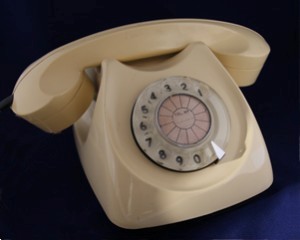Siemens Centenary Neophone

The Centenary Neophone was a new phone for a new age. It celebrated the launch of the Siemens Brothers Company in 1858, but just as the original Neophone from 1929, defined the look of phones in the Art Deco era, the Centenary Neophone was a phone for the 1950s.
The new design used new thermoplastics materials, which were not brittle and easily breakable like the thermosetting plastic, Bakelite, used for the original Neophone and it was the first telephone to have use a printed circuit board.
John Barnes of Allen-Bowden designed the Centenary Neophone. Barnes joined Allen-Bowden soon after leaving art college. In one of his first projects he assisted Ben Bowden on the design of the 'Bicycle of the Future' for the Britain can make it exhibition in 1946. The 'Bicycle of the Future' was streamlined bike which was eventually manufactured for the US market.
Barnes worked mainly on industrial and building products. His work included toilet cisterns, basins and domestic heaters as well as heavy industrial furnaces. Barnes also designed the white Avery scales seen in many shops and post offices in the 1960s as well as some precision balances for Avery. He eventually became Chairman of Allen-Bowden.
Siemens Edison Swan Ltd, as the original Siemens Brothers was now called, Barnes, of a skeleton of the phone containing the functional electronic parts. He designed the case and handset around this after suggesting some re-arrangement of the pasts to make the phone streamlined.
Barnes' design kept the classic the classic telephone dial at a 45° angle and had the receiver was in the traditional East-West orientation. However the new phone itself was a fluid organic form following the favoured style of the 50s. At the same time it was an incredibly practical and thoughtful design. The sculptural shape of the handle is modelled perfectly to make it easy to pick up and it rest securely on top of the phone when replaced.
The front of the phone feature a wide groove which gave it the appearance of a horseshoe. This area was intended to be used to display letters for countries that needed lettered dials. It was usually left blank. The handset on the original version was moulded in two parts. The line along the of the handset was meant to hide any excess adhesive. In later versions the handset is moulded in one piece.
The original Centenary Neophone was sold in several colours: black, ivory, black and ivory, ivory and red, grey with maroon, red, green, oatmeal and dark grey.
It was never supplied by the GPO, but was used used in many countries in the 1950s and 1960s.I rescued the phone on this page from a junk shop in Cape Town, South Africa.; It was designed for tropical climates, with mesh to prevent insects from entering the case.
References
'Style and technique for telephones' by John Gray, published in Design, November 1957.
'How design consultants work' by Corin Hughes-Stanton, published in Design, October 1966.
'Case Study: Ben Bowden Bicycle of the Future' by Paul Clarke, published in Journal of Design History (vol 5 no 3)1992


Comments